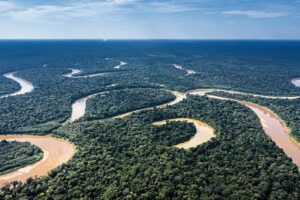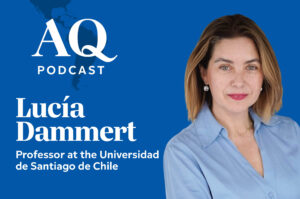Environmental Crime Is a Critical Threat to the Americas
November 3, 2025
Reading Time: 4 minutes
It’s no secret that Latin America’s organized crime has been evolving as it diversifies from drugs to other revenue streams. But in many places, the scale and speed of the shift has taken policymakers by surprise.
By some estimates, illegal gold mining, for example, now generates more revenue for organized crime groups in Peru and Colombia than cocaine.
This is part of a broader trend called “environmental crime convergence”: Throughout the region, major transnational criminal organizations (TCOs) are entering and then dominating illegal mining, logging, fishing, wildlife trafficking, and other illicit activities traditionally thought of as conservation problems. These offenses are rapidly becoming more interconnected, more integrated into TCO operations, and, most importantly, vital to their bottom lines. It’s a growth industry that has metastasized into a multibillion-dollar underground economy that destroys forests, poisons rivers, erodes the rule of law, and finances criminal and authoritarian networks.
While the data on the size of environmental crime in Latin America is difficult to gather and quantify, it likely runs high into the billions of dollars annually. Some estimates signal that global illegal gold mining brings in as much as $48 billion annually, contributing to a much larger global flow that adds up to an industry worth $281 billion when other illicit activities are included, according to the Financial Action Task Force (FATF).
The proceeds of environmental crime are laundered through real estate, commodity chains, and financial networks, weakening tax bases and corrupting officials. And to some extent, environmental crime is also reshaping geopolitics at the local level: Illegal resource revenues fund armed groups, rent-seeking elites, and patronage networks that subvert democratic accountability.
The story is not uniform across the region. In some places, environmental crime looks like artisanal miners clearing rainforest along riverbanks; in others, it is industrial-scale illegal logging or transnational wildlife trafficking rings using air cargo and major ports. But the economic logic is the same: where enforcement is weak, demand is strong, and governance is porous, crime fills the void. A recent survey found that 91% of forest loss in the Brazilian Amazon is linked to illegal activity such as land-clearing for agriculture and artisanal mining, often orchestrated by well-structured international criminal enterprises, according to the World Resources Institute (WRI).
Broadly speaking, crimes like these can no longer be treated as merely environmental protection issues. The money they bring in is now core to major TCO revenue streams, and unless law enforcement takes them seriously, efforts to curb organized crime are likely to fail.
A growing threat
Illegal mining operations, which have deep ties to transnational organized crime groups and have spread rapidly throughout the Amazon basin and elsewhere in Latin America, are now regularly undertaken alongside a range of other crimes. A slew of investigations have revealed a new modus operandi for organized crime groups operating in areas that seem promising for mining.
Their workers clear-cut forests and sell off the timber. Then they graze cattle or plant coca. They hunt jaguars and other animals whose body parts sell at a premium across the Pacific in traditional Asian medicines, but also set giant nets across rivers to catch everything that might make a quick buck at the local market.
The good news, relatively speaking, is that this convergence makes organized crime activity easier to spot and disrupt. “We can see from satellite images what’s happening on the ground with deforestation and mining,” said Charles Barber, the natural resources governance director at the World Resources Institute, in a major report earlier this year on the deepening ties between environmental crime, corruption, and human rights abuses.
Convergence
Over the past six years of monitoring in the Amazon, Earth League International (ELI) has documented how major transnational groups like the Colombian FARC-D and the Brazilian PCC, generally associated with drug trafficking, have made environmental crime integral to their operations. As ELI mapped and photographed hundreds of their dredges and other mining operations, we witnessed a sharp increase in poaching and a range of other offenses. We even saw the FARC-D open illegal eco-lodges to foreign tourists in protected areas.
The damage abounds: Illegal mining dumps an estimated 30 tons of mercury into the Amazon region’s waterways every year, contaminating rivers, poisoning people and wildlife, and facilitating deforestation. In Colombia, two-thirds of illegal mines are in natural parks and reserves, where it’s estimated that the equivalent of 1,000 soccer fields are cleared daily. Sex trafficking and deadly attacks on government security forces come with the territory. The scale of these operations illustrates not only the ecological cost, but also how important they are to their perpetrators, who are making a killing.
Fighting back
It’s increasingly clear that to tackle organized crime, law enforcement agencies must also address environmental crime. But recent efforts across the region have likewise shown that with enough political will, law enforcement can push back.
Brazil’s recent crackdown on illegal gold mining in the Yanomami Indigenous Reserve, along the country’s far northern border with Venezuela, for example, shows that sustained enforcement can work even in the remotest regions. Thousands of wildcat miners were displaced after law enforcement “dynamited 42 clandestine airstrips used by the miners in the rainforest, set fire to 18 aircraft, seized 92,000 liters of diesel, sunk 45 dredging barges, destroyed 700 pumps, and dismantled 90 Starlink dishes that allowed the miners to warn each other about enforcement teams,” according to a Brazilian official.
At least temporarily, enforcement appears to have curbed the malnutrition and infectious diseases that illegal miners brought to the Yanomami people, thousands of whom live in isolation in the Amazon forest.
But the wildcat miners are trickling back into the area, and the Yanomami continue to suffer. Disruption of organized criminal networks requires not temporary operations but sustained, coordinated action.
Policymakers in the region need to treat environmental crime as a core security and financial crime problem. Governments must integrate environmental intelligence into customs, anti-money laundering units, and procurement audits. Prosecutions must follow the money: identifying shell companies, tracing real estate, and cross-border trade flows. Environmental crimes are no longer a sideshow for TCOs. Instead, they are major sources of cash. To see positive results, any effort to tackle TCOs like the FARC-D or the PCC will have to clamp down on these arteries of illicit revenue.
Tags: Amazon, Brazil, environmental crime, organized crime
Search
RECENT PRESS RELEASES
Related Post







